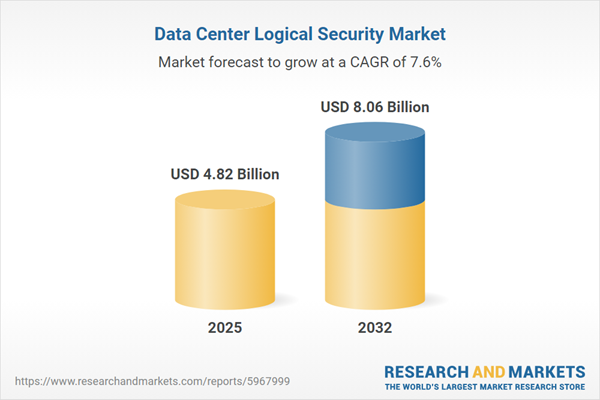Speak directly to the analyst to clarify any post sales queries you may have.
The data center logical security market is rapidly evolving as businesses embrace digital transformation, hybrid cloud, and new technological frameworks. Organizations face increasing challenges to protect infrastructure, ensure resilience, and sustain operational continuity amid escalating threat complexity.
Market Snapshot: Data Center Logical Security Market Growth and Opportunity
The Data Center Logical Security Market grew from USD 4.47 billion in 2024 to USD 4.82 billion in 2025. Continuing on this trajectory, it is projected to reach USD 8.06 billion by 2032, reflecting a robust CAGR of 7.63%. This growth underscores the strategic focus organizations place on modernizing logical security controls to address cloud adoption, identity-centric attacks, and advanced threat vectors.
Scope & Segmentation
This research delivers a granular analysis of core market dimensions, strategic segments, key regions, and leading enterprises:
- Identity and Access Management: Identity Governance and Administration, Multi-Factor Authentication (including Hardware Token, Push Notification, Time-Based One-Time Password, Biometric MFA, Push Notification MFA), Privileged Access Management, Single Sign-On
- Security Information and Event Management: Cloud, Hybrid, On Premises
- Data Loss Prevention: Cloud, Endpoint, Network
- Encryption: Data At Rest, Data In Transit, Database
- Network Access Control: Agent Based, Agentless
- Geographic Coverage: Americas (North America: United States, Canada, Mexico; Latin America: Brazil, Argentina, Chile, Colombia, Peru); Europe, Middle East & Africa (Europe: United Kingdom, Germany, France, Russia, Italy, Spain, Netherlands, Sweden, Poland, Switzerland; Middle East: United Arab Emirates, Saudi Arabia, Qatar, Turkey, Israel; Africa: South Africa, Nigeria, Egypt, Kenya); Asia-Pacific (China, India, Japan, Australia, South Korea, Indonesia, Thailand, Malaysia, Singapore, Taiwan)
- Companies Profiled: Fortinet, Palo Alto Networks, Check Point Software Technologies, Cisco Systems, Juniper Networks, VMware, F5 Networks, IBM, Trend Micro, Sophos
Key Takeaways for Senior Decision-Makers
- Wider adoption of cloud and hybrid environments is extending the attack surface, bringing new demands on security policy, event correlation, and adaptive access controls.
- Zero trust frameworks are now central to logical security architectures, with continuous authentication and rigorous identity verification required for all user and workload interactions.
- The rise of AI-driven threats and advanced persistent tactics underscores the need to invest in real-time analytics, behavioral monitoring, and machine learning–enhanced event management.
- Regulatory changes, particularly around privacy, breach notification, and cross-border data flows, are driving alignment of access controls, encryption policies, and incident response mechanisms.
- Physical and logical security procurement decisions are increasingly affected by external factors such as tariffs, prompting the integration of software-centric solutions and managed security services to manage cost and operational complexity.
- Regional security adoption reflects localized compliance mandates, cloud migration pace, and collaboration across public and private sectors, shaping technology investment priorities worldwide.
Tariff Impact: Adjusting Data Center Security Procurement
Recent tariff measures in the United States have introduced new cost considerations for hardware-based security solutions. Security leaders are responding by exploring software-driven authentication and managed services, as well as adjusting vendor relationships and lengthening their procurement timelines to balance compliance with budget objectives. Organizations with advanced sourcing practices are mitigating disruptions through multi-vendor negotiations and resilient supply chain planning.
Methodology & Data Sources
This research applies a combination of primary interviews with security architects, CIOs, and compliance officers, along with structured surveys across multiple sectors. Secondary sources, including regulatory documents and technical whitepapers, are used to contextualize segmentation and vendor innovation. Findings are validated through expert peer review, triangulation, and analytical models such as SWOT and risk-impact matrices.
Why This Report Matters
- Enables informed, strategic decision-making for security, IT, and procurement leaders by providing actionable insights on evolving market dynamics and technology adoption.
- Helps organizations benchmark their logical security posture against global trends and regulatory developments, supporting compliance and risk mitigation initiatives.
- Facilitates resilient investment planning through practical analysis of technology segmentation, tariff impact, and competitive positioning.
Conclusion
Organizations must accelerate their transition toward adaptive, identity-driven logical security architectures as cloud, threat, and regulatory complexities intensify. With actionable regional and segment insights, this report is designed to empower decision-makers to confidently strengthen their data center logical security strategies.
Additional Product Information:
- Purchase of this report includes 1 year online access with quarterly updates.
- This report can be updated on request. Please contact our Customer Experience team using the Ask a Question widget on our website.
Table of Contents
3. Executive Summary
4. Market Overview
7. Cumulative Impact of Artificial Intelligence 2025
Companies Mentioned
The companies profiled in this Data Center Logical Security market report include:- Fortinet, Inc.
- Palo Alto Networks, Inc.
- Check Point Software Technologies Ltd.
- Cisco Systems, Inc.
- Juniper Networks, Inc.
- VMware, Inc.
- F5 Networks, Inc.
- International Business Machines Corporation
- Trend Micro Incorporated
- Sophos Ltd.
Table Information
| Report Attribute | Details |
|---|---|
| No. of Pages | 189 |
| Published | October 2025 |
| Forecast Period | 2025 - 2032 |
| Estimated Market Value ( USD | $ 4.82 Billion |
| Forecasted Market Value ( USD | $ 8.06 Billion |
| Compound Annual Growth Rate | 7.6% |
| Regions Covered | Global |
| No. of Companies Mentioned | 11 |









